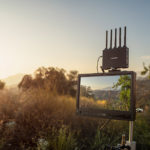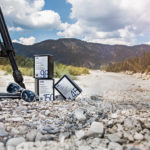
Hive Bumble Bee
Posted on Aug 21, 2019 by Julian Mitchell
Hive lighting is concentrating on high-output LED lighting but that doesn’t mean that their small lights are any less innovative
 The Hive Bumble Bee 25-C is tiny, only two and a half inches long and under 500g in weight
The Hive Bumble Bee 25-C is tiny, only two and a half inches long and under 500g in weight
Words / Phil Rhodes
Price £350/$299
Until recently, LED lighting was mostly limited in power to about the size of a very small HMI. Over the last year, more and more powerful options have emerged, until NAB 2019, where Hive Lighting showed a prototype 575W LED that should outdo a 575W HMI in sheer output and offers full colour mixing. While the world is pushing for more power, though, Hive has also launched its smallest ever light.
The Bumble Bee is a 25W LED that follows the established design of Hive’s hard-light LED family quite closely. The company is unusual in that it produces (among other things) LED hard lights, which represent much more difficult engineering than the common soft light panels. The design of LED lights is mainly about managing heat, and concentrating all of the emitters together in a tiny area makes it even more difficult to stop things melting. The light under review was a prototype, missing a couple of features such as a locking power connector, which is reportedly under consideration for the final version.
Connections
The company is planning accessories to allow for battery power, but for now takes power from a mains power supply via a common coaxial DC connector. Most of Hive’s hard light range uses XLR connectors, but it’s immediately obvious why they’ve been omitted here: it would have been too bulky, as the 25W Bumble Bee is tiny. Alongside the DC jack is a pair of miniature 3-pin XLRs for DMX, the remote-control antenna, and not much else, no power switch nor any on-board control of brightness or colour. The light maintains the same 100mm diameter of the others in the range, which ensures compatibility with Profoto accessories and allows for the same tidy ring clamp mount. The upside to all this miniaturisation is that the light is two and a half inches long and weighs under half a kilo.
The Bumble Bee is essentially a driver module, available in kits with various modifiers, from PARs to Fresnels. Perhaps the most immediately useful accessories are the clip-on Fresnels, which use a crafty combination of collimating and Fresnel lens elements in a single moulding and snap easily onto the front of the emitter. Because that lens is then not enclosed, there is a small amount of sideways leakage, but no more than some theatrical lighting. There is currently no way to put barn doors on the front of these, but there are other options via Profoto accessories if that’s a requirement. Hive also supplied a narrow parabolic reflector, which produces a nicely defined beam.

App
Control of colour, saturation and colour temperature (of white light) is via a smartphone app, which scans automatically for nearby lights. Lights can be assigned to groups, and there’s the option to store and recall several colour settings, stored optionally either on the light or in the app. It’s all very straightforward, and unlike some lights there’s no distinction between colour and white modes – for white light simply turn down the saturation. There is no explicit user interface for magenta-green shift, though it can be achieved using a little creativity with the hue and saturation controls.
Photometric measurements were taken with a UPRTek CV600 colour meter at 2800, 3200, 4200, 5600, 6500 and 8000K colour temperatures, and at 100, 50 and 5% intensity, with the medium-dispersion Fresnel lens installed. The UPRTek meter declined to calculate a CCT or TLCI for the minimum 1650K setting, which is reasonable given most people would describe it as “amber.” Most LED lighting maintains its colour quality less well at very low output, and the worst-case TLCI on the Bumble Bee is a perfectly acceptable 83 at 5% power with 5600K selected. TLCI rises to 86 at the same selected colour temperature at 100%.
Otherwise, colour quality is generally better with warmer light, as is the case with most LED lighting; warmer colours convert more of the blue LEDs’ output to orange and yellow using phosphors, which usually have a broader spectrum of output than simple coloured LEDs. Measured colour temperature was generally 200-300K lower than indicated, which is a slightly-visible error through most of the range, though most people will simply eyeball the match anyway. Light output is reasonably consistent over the CCT range, generally measuring around 540 lux at beam centre one metre from the light, with a slight fall-off to 450 at 6500K.
 The colour, saturation and colour temperature of the Bumble Bee 25-C can be controlled via an app
The colour, saturation and colour temperature of the Bumble Bee 25-C can be controlled via an app
White emitters
The Bumble Bee is perhaps unusual in that it has no white-emitting LEDs; it mixes its white from red, green and blue LEDs, which more or less requires phosphor-converted LEDs for acceptable-quality white. There isn’t really a standard for assessing saturated colour light output; it’s noticeable that the phosphor-converted green (Hive calls it “lime green”) LED is fairly desaturated, and the Bumble Bee is not capable of producing a deep, saturated green, which affects its ability to produce deep yellows. This is reportedly an engineering compromise around size: the tiny 25W emitter simply lacks the space for more colours.
Hive sells a lot of lighting to museums, exhibitions and other installations, but it’s easy to imagine the Bumble Bee being used on TV gameshow sets and as an accent light in a jobbing camera operator’s kit bag. At a frugal 25W it’ll never be an absolute powerhouse, but neither is it very power hungry and, especially with the PAR reflector, might work well as a colour-matching fill or hair light for interviews. Hive promotes the Bumble Bee 25-C at $299, and they have many other options if anyone feels the need to go for more power with the same features. There are comparatively few LED hard lights and very few which offer full colour mixing; the Bumble Bee is both and as such rounds out Hive’s range nicely.








